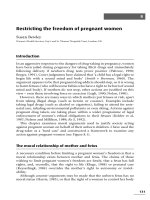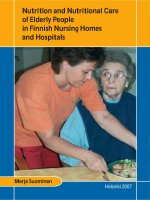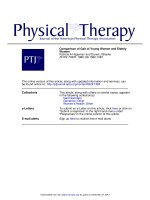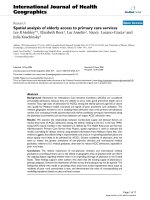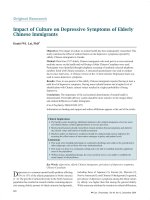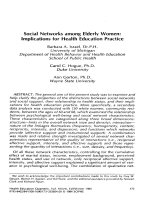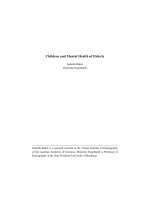Clothing preferences of elderly women
Bạn đang xem bản rút gọn của tài liệu. Xem và tải ngay bản đầy đủ của tài liệu tại đây (206.81 KB, 6 trang )
Int.J.Curr.Microbiol.App.Sci (2019) 8(3): 1813-1818
International Journal of Current Microbiology and Applied Sciences
ISSN: 2319-7706 Volume 8 Number 03 (2019)
Journal homepage:
Original Research Article
/>
Clothing Preferences of Elderly Women
Vivek Singh, Nisha Arya*, Neha Chauhan and Sarita Devi
Department of Textile and Apparel Designing, I. C. College of Home Science,
CCSHAU, Hisar, Haryana, India
*Corresponding author
ABSTRACT
Keywords
Aesthetic,
Clothing, Elderly,
Fashionable, Fit
Article Info
Accepted:
15 February 2019
Available Online:
10 March 2019
The focus of this paper is to analyze the elderly and the market to help them to buy more
suitable garments. With the increasing in the average age of populations across the world
and extending life expectancies, the designers should consider in terms of designing and
manufacturing of more functional and fashionable clothing. The potential for supplying
improved fit and functional garment for them should be considered. In this paper, from this
perspective, the discourses of making an assay of the elderly markets are relevant to the
elderly to do more objective selection about their cloth. Based on elaborating the elderly
themselves and the market roundly, permitting to improve the elderly‟s fitting perception
of a garment. The special requirements on fabric properties and design applications and
their relevance to the provision of functional and aesthetic clothing are to meet their
special needs.
Introduction
to be worn, the type of role and age of person
(Singh and Arya, 2017b).
Clothing is one domain that protect, to cover
and to beautify his/ her body which is of great
importance that is supposed to fulfill both
functional and symbolic needs of the
consumers (Nandini and Jeevananda, 2015).
Clothing influences a person socially,
psychologically and emotionally (Arya and
Singh, 2017). Clothing that is neat and clean,
fits well, and feels good can boost anyone‟s
morale. Clothing should be appropriate for the
person for whom it has been designed. Some
of the important considerations which should
be taken are climate of the region, season of
the year for which the garment is made, the
time or type of occasion when it is most likely
Every change in a life- situation- birth,
entering school, college, getting a job,
marriage, parenthood and even death requires
a change in wardrobe. Even in the course of
daily life, situation after situation requires a
change in dress to facilitate and symbolize the
situational change. Old age is a period when
women experiences lot of changes (Arya and
Singh, 2016). Clothes mediate between the
naked body and the social world, the self and
society, presenting a means whereby social
expectations in relation to age act upon and
are made manifest in the body. They thus play
a potentially important role in our
1813
Int.J.Curr.Microbiol.App.Sci (2019) 8(3): 1813-1818
understanding of the cultural processes of
ageing (Arya et al., 2017).
Clothes are central to the ways older bodies
are experienced, presented and understood
within culture, so that dress forms a
significant, though neglected, element in the
constitution and experience of old age. Dress
is, however, also an arena for the expression
of identity.Clothing is significant because it
mediates the relationship between the body
and the social world, forming the
vestimentary envelope that contains and
makes manifest the body, offering a means
whereby it is experienced, presented and
given meaning in particular social contexts
(Twigg, 2007).
Older people often are anxious about their
appearance. They may be uncomfortable
wearing the clothes they have, especially if
those clothes are out of date, are in colors or
designs that are no longer flattering, are
mismatched, or simply no longer fit properly.
Our clothing for elderly women needs for
easy dressing, comfort and style while
addressing the challenges of potential
decreased mobility, need for maintenance of
independence and the possible need for
assisted dressing.
Older people have the right to make selections
about their clothing. Clothing for elderly
should be such that it makes them feel good
about their appearance, and that will be easy
to wear and care for. While selecting clothing
for older people, the person‟s need for
clothing that he or she enjoys; clothing that
enhances appearance, increases independence,
allows for function, and provides comfort
must be considered. Clothing can help older
people feel better about them and present a
positive image to those around them. Sending
positive appearance messages may increase
older people‟s opportunities for social
interaction. Good clothing choices for older
people
enhance
appearance,
increase
independence, allow for daily functioning,
and provide comfort, safety, and convenience.
Besides health factors, there are other factors
that determine the clothing requirement of the
elderly. These are the types of activities they
engage in on a regular basis and culture.
Clothing without doubt is central to the ways
older bodies are experienced, presented, and
understood within culture, so that „clothing
and age‟ forms a significant though neglected
element in the constitution and experience of
old age (Twigg, 2007).
This elaborate study revealed a lot about the
relation between clothing, ageing and culture.
It concluded that clothes are the primary
means through which the body is presented,
how dress operates in relation to age and is
significant for understanding in what way
cultural expectations act directly at a bodily
level.
Furthermore, it revealed that clothing choices
in old age reflect changes in the body and
dress thus offers a field in which the complete
interplay between physiological and cultural
influences in the constitution of old age can
be explored. Clothing has also traditionally
embedded age ordering even though the
phenomenon seems elusive. Clothing
therefore is seen as an everyday bodily
practice in which various influences including
those of fashion, culture, age, identity, etc.
come into play. Hence, study was conducted
to determine the clothing needs of rural
elderly women by gathering information on
existing clothing practices, preferences and
problems with existing dresses.
The main objectives includes to study the
existing clothing practices of elderly women.
And also to study the preferences of elderly
women for various garments
1814
Int.J.Curr.Microbiol.App.Sci (2019) 8(3): 1813-1818
Materials and Methods
Interview schedule was prepared to collect
information regarding clothing practices of
elderly women and problems encountered
with existing clothing practices. Their
preferences for different types of garments,
fabric and various constructional features for
upper garments were also studied.
The experiment was conducted in four
villagesof Sonipat district (Jagdishpur,
Shahpur, Fazilpur and Raipur) of Haryana.
The data was collected from twenty
respondents from each village, comprising a
total of eighty respondents.
Clothing practices of elderly women and their
preferences for different types of garments
were studied and responses were tabulated
using frequency and percentages.
Results and Discussion
Clothing practices of elderly women and their
preferences for different types of garments,
fabric and various constructional features for
upper garments were studied using self
structured interview schedule. Information
regarding clothing practices, problems
encountered by rural elderly women with
existing clothing practices, preferences
regarding fabric and various constructional
features of upper garments has been presented
in Table 1 to 4.
Data regarding existing clothing practices of
rural elderly women has been presented in
Table 1. It is clear from the data that half of
the rural women (55%), used to wear short
straight kameez with salwar followed by kurti
with salwar which was worn by 45%
respondents.
Thus, majority of rural women used to wear
straight kameez with salwar followed by
kurtiwith salwar.
The data presented in Table 2 revealed that
near about half of rural women (52.2 were not
satisfied with length of opening in upper
garments i.e. kameez & kurti followed by the
problem of improper length of armhole in
upper garments faced by 32.5% rural elderly
women. Thirty percent elderly women, also
considered the use of stiffening material i.e.
tetron in band, collar, cuffs and pauncha,
uncomfortable. A few rural women i.e. 10%
also considered use of string in lower garment
for tying as uncomfortable.
Thus, nearly half of rural women were not
satisfied with length of front opening and
thirty three percent with length of armhole.
The data related to various attributes of fabric
preferred by rural elderly women has been
presented in Table 3. The data revealed that
majority of rural elderly women (80%)
preferred cotton blend fabric followed by
cotton fabric by 20% respondents.
Light colors were preferred by majority of
rural women (80%). Twenty percent
respondents preferred dark & dull colors.
As far as print of the fabric was concerned, it
was found that hundred percent respondents
preferred small & dense floral prints followed
by scattered prints, which were preferred by
22.5% rural elderly women. Plain fabric was
also preferred by 15% respondents.
Thus, majority of rural elderly women
preferred cotton blend fabric of light color
with small dense floral prints.
The data regarding preference of rural elderly
women for various constructional features of
upper garments has been presented in Table 4.
Data pertaining to silhouette of kameez
showed that hundred percent respondents
preferred straight silhouette of kameez
1815
Int.J.Curr.Microbiol.App.Sci (2019) 8(3): 1813-1818
followed by A-line silhouette of kurti with
round hemline preferred by near about half of
respondents (45%).
It was found that near about half of the
respondents (55%) preferred 8 to 12” long
side slits in their kameez followed by 6” long
side slits in their kurti by 45% respondents.
Table.1 Existing clothing practices of rural elderly women N=80
Type of dresses
Short straight kameez with
salwar
Kurti with salwar
Short kameez with lehnga
Respondents
44(55%)
36(45%)
-
Table.2 Problems encountered by rural elderly women with existing clothing practices (N= 80)
S.
No.
1.
2.
3.
4.
Problems
Frequency Percentage
Use of stiffening material is uncomfortable
Improper length of armhole
Improper length of opening
Use of string
24
26
42
08
30
32.5
52.5
10
Table.3 Preferences of rural elderly women regarding fabric (N=80)
Features
Fabric
Color intensity
Fabric print
Categories
Cotton
Cotton blend
Synthetic
Dark
Dull
Bright
Light
Plain
Floral
Abstract
Small
Bold
Dense
Scattered
1816
Frequency (percentage)
16 (20%)
64 (80%)
16 (20%)
16 (20%)
64(80%)
12(15%)
80(100%)
80(100%)
80(100%)
18(22.5%)
Int.J.Curr.Microbiol.App.Sci (2019) 8(3): 1813-1818
Table.4 Preferences of respondents regarding various constructional features of upper garments
(N=80)
Features
Silhouette
Fitting
Necklines
Openings
Length of opening
Sleeve type
Sleeve length
Side slits
Categories
Straight
A-line with round hemline
Flared
Fitted all over
Loose all over
Loose at bust to hip level
Square
Round
Neck with band /collar
Front
Back
Shoulder
Up to bust line
Up to waistline
Up to hip line
Full length
Simple
Designed (with cuff)
Half sleeves
¾ sleeves
full sleeve
Up to 6‟‟
8-12‟‟
More than 12‟‟
As far as fitting of upper garments was
concerned, hundred percent respondents
preferred all over loose upper garments i.e.
lady‟s kameez and kurtis.
It is evident from the data presented in Table
4 that near about half of the respondents
(55%) preferred round neck followed by neck
with band or collar by 45% respondents.
Hundred percent rural elderly women
preferred front opening up to waist line in
their upper garments.
The data regarding type of sleeve and length
of sleeve indicated that hundred percent
Frequency (percentage)
80(100%)
36(45%)
80(100%)
44(55)
36 (45)
80(100%)
80(100%)
80(100%)
36(45%)
80(100%)
64(80%)
36(45%)
44(55%)
-
respondents preferred simple sleeve with ¾
length followed by full sleeve by 80%
respondents.
It was concluded that all the respondents
preferred straight all over loose kameez with
up to waist line front opening and simple ¾
length sleeves.
In conclusion, a major common problem that
many rural elderly women experience is the
act of getting dressed and to undressed
themselves. This might be the result of any
physical disability, chronic condition, and/or
other restrictions that comes with age.
Therefore, as the result of major physiological
1817
Int.J.Curr.Microbiol.App.Sci (2019) 8(3): 1813-1818
changes at this specific stage, the clothing
preferences of the elderly women have
transformed from beautiful and designer to
classic and functional. Elderly is the specific
stage of life where functional clothing can be
of countless help. Functional clothing makes
life simpler for elderly women and also for
their care takers.
References
Arya N, Singh V 2016. Preferences regarding
constructional and designing features
of kameez for urban lactating women.
Indian Journal of Research, 5(10):
246-248.
Arya N, Singh V, Yadav N2017. Reliability
assessment of functional clothing for
lactating women. Asian Journal of
Home Science, 12 (2):402-40.
Arya N, Singh V 2017. Existing clothing
practices of urban lactating mothers.
International Journal of Scientific
Research, 6(4): 451-452.
Bhatia
D,
Malhotra
U
2016.
Thermophysiological Wear Comfort
of Clothing: An Overview. Journal of
Textile Science Engineering, 6(2): 1-8.
Gilleard C 2018. Suffering: The darker side of
ageing. Journal of Aging Studies, 44:
28-33.
Lawrence R, Lawrence M, Robert M 2005.
Breastfeeding – A guide for the
medical profession sixth edition.
Mosby. Philadelphia.
Nandini R, Jeevananda S 2015. A study on
association between factors of fashion
clothing and overall involvement.
BIMS International Journal of Social
Science Research, 77-87.
Piacentini M, Mailer G 2009. Symbolic
consumption in Teenagers clothing
choices. Journal of Consumer
Behaviour, 3(3): 251–262.
Raeve AD, Vasile S, Cools J 2018.Selected
factors influencing wear comfort of
clothing: case studies. Journal of
Textile Engineering & Fashion
Technology, 4(1): 66‒71.
Singh V, Arya N 2017a. Preferences
regarding functional kameez for rural
lactating
women.
International
Research
Journal
of
Human
Resources and Social Sciences,
4(1):31-35.
Singh V, Arya N 2017b. Clothing practices of
rural lactating women. International
Journal of Applied Research, 3(4):
718-720.
Tuchtan V 2015. Helping the elderly with
grooming and hygiene. Retrieved from
on
November 28, 2018.
Twigg J 2007. “Clothing, age and the body: A
critical review”. Ageing. United
Kingdom: Cambridge University
Press.
Twigg J2009. Clothing, Identity and the
Embodiment of Age. Aging and
Identity: A Postmodern Dialogue, 119.
Wang X, Xu D 2010. Study on the Clothing
for the Elderly. Proceedings of the
2010 International Conference on
Information Technology and Scientific
Management. Scientific Research. 5660.
How to cite this article:
Vivek Singh, Nisha Arya, Neha Chauhan and Sarita Devi. 2019. Clothing Preferences of
Elderly Women. Int.J.Curr.Microbiol.App.Sci. 8(03): 1813-1818.
doi: />1818
